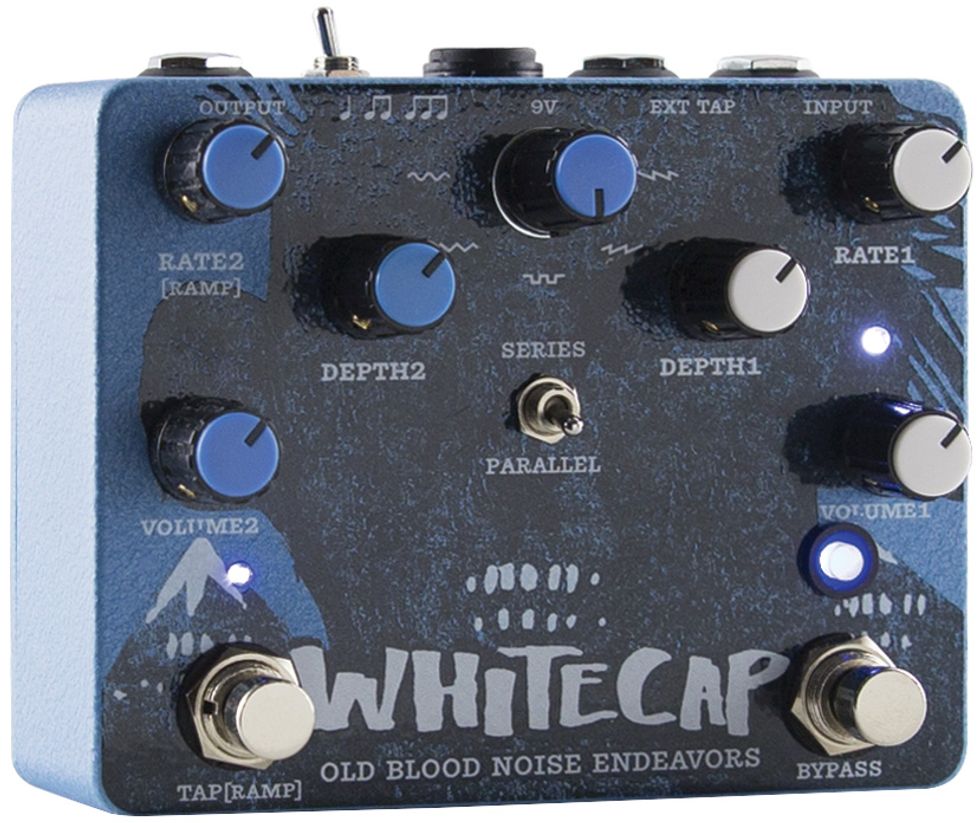RatingsPros:Distinctive dual-tremolo sounds. Great for glitchy, quasi-random effects. Cons: Mono only. No expression control. Street: $199 Old Blood Noise Endeavors Whitecap Tremolo oldbloodnoise.com | Tones: Ease of Use: Build/Design: Value: |
Would you rather play an analog tremolo pedal or a digital one?
That’s a trick question—at least if you embark for pulsation paradise with the latest gizmo from Oklahoma’s Old Blood Noise Endeavors. Their Whitecap pedal unites independent analog and digital tremolo in a single BB-sized stompbox.
Twofold Trem
Why two tremolo circuits? A single tremolo circuit generates consistent and predictable volume pulsations. But with two trems, the results are the opposite of predictable.
Applying a mild tremolo effect to a strong one can impart the uneasy rhythm of a car driving with a flat tire. With two fast trem speeds, sustained notes and chords can sound as if they’re running through a synthesizer’s sample-and-hold filter. You can mimic bad cables and intermittent radio transmissions. Fast rates and shallow depth settings can introduce ring-modulation-like distortion. Applying the latter effect to distorted tones lends a thorny, inharmonic edge that you might not even perceive as a tremolo effect. Fast rates and high depth evoke the childhood pastime of inserting playing cards between a bike’s spokes for a thrumming motor effect—after you’ve removed some of the spokes. If chaos makes you nervous, so will Whitecap.
State of Independence
Using Whitecap is almost like playing through two separate tremolo pedals, an arrangement that has plusses and minuses. The two trems have independent rate and depth controls. Asynchronous rhythms aren’t just an option—they’re the only way to play here. You can’t, for example, have one side pulsate in a precise ratio to the other. Their clocks don’t communicate with each other.
The two trems lack separate on/off footswitches, but there’s a clever workaround: Each trem has its own volume control. With the digital side at minimum volume, you hear only the analog effect, and vice versa. This produces conventional single-oscillator tremolo.
Analog tremolo is fairly easy to mimic digitally, and the Spin FV-1 chip at the heart of the digital circuit does this well. But that means there isn’t a particularly dramatic tonal contrast between the analog and digital effects. Both dispense perfectly fine, if unexceptional, traditional trem. The action starts when you blend the circuits.
Separate but Unequal
The pedal’s independent volume controls contribute to its sonic range. Adjusting their relative levels isn’t the same as adjusting their relative depths, though those parameters too are interactive. Also, these are active volume controls, so you can output more than enough level to overdrive an amp. With the dual depth controls zeroed out, Whitecap becomes a perfectly respectable clean boost.
While the analog side has only rate, depth, and volume controls, the second trem can do several digital tricks. A dedicated tap-tempo switch only affects the digital side. While you can’t sync both sides using a tapped rhythm, tempo-shifting only the digital trem yields ever-shifting rhythmic collisions that heighten the sense of randomness. It’s the Alexander Calder mobile of modulation effects. You can also connect an external foot switch (not included) to the rear-panel tap-tempo jack, which might come in handy if Whitecap occupies a hard-to-access pedalboard location. Whitecap runs on standard 9V power supplies (adapter not included). It has no battery compartment.
Ramp Champ
The digital trem also offers a choice of five waveforms: traditional-sounding sine and triangle waves, forward and reverse sawtooth waves for a slightly choppier effect, and a square wave for blunt on/off oscillation. The rear panel’s time-division switch specifies whether the modulation rate equals your tapped tempo, or pulses at two or three times the tapped rate.
The tap-tempo switch also doubles as a ramp effect. It’s a crafty arrangement: You specify the rate and direction of the ramp effect by turning one of the rate knobs while depressing the tap-tempo switch. After that, you trigger the ramp effect by press/holding the tap tempo switch. When you release the switch, the digital tremolo returns to its previous rate. Result? Yup, even more ways to concoct chaotic, quasi-random pulsations.
Finally, a 2-way toggle configures the trems in parallel or in series. In parallel, you get volume fluctuations in two contrasting rhythms, but the collective level doesn’t vary. In series, the digital tremolo alters the level of the analog trem. In other words, it’s wobblier.
The Verdict
Whitecap is an ingenious double-headed tremolo capable of countless anarchic and seemingly random pulsation patterns. It easily adds wild-card chaos to otherwise straightforward tones. Its unpredictability may unnerve control freaks, but appeal to players eager to cast their sonic fate to the winds.








![Rig Rundown: Russian Circles’ Mike Sullivan [2025]](https://www.premierguitar.com/media-library/youtube.jpg?id=62303631&width=1245&height=700&quality=70&coordinates=0%2C0%2C0%2C0)

















